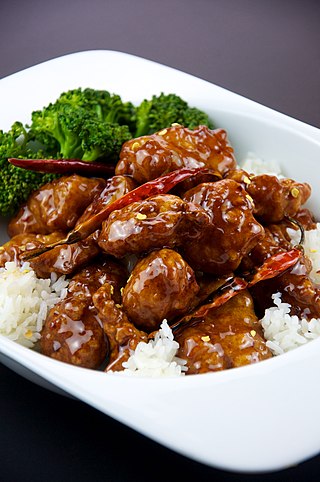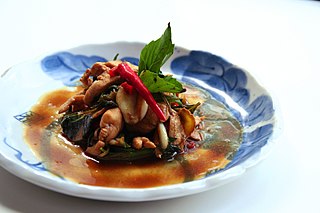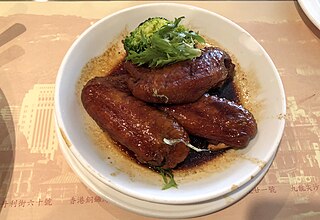
American Chinese cuisine is a cuisine derived from Chinese cuisine that was developed by Chinese Americans. The dishes served in many North American Chinese restaurants are adapted to American tastes and often differ significantly from those found in China.

Sichuan cuisine or Sichuanese cuisine, alternatively romanized as Szechwan cuisine or Szechuan cuisine, is a style of Chinese cuisine originating from Sichuan province and the neighboring Chongqing municipality. Chongqing was formerly a part of Sichuan until 1997; thus, there is a great deal of cultural overlap between the two administrative divisions. There are many regional, local variations of Sichuanese cuisine within Sichuan and Chongqing.

Shanghai cuisine, also known as Hu cuisine, is a popular style of Chinese food. In a narrow sense, Shanghai cuisine refers only to what is traditionally called Benbang cuisine which originated in Shanghai. In a broader sense, it refers to complex styles of cooking developed under the influence of neighboring Jiangsu and Zhejiang provinces.

General Tso's chicken is a sweet and spicy deep-fried chicken dish.

Sanbeiji is a popular chicken dish in Chinese cuisine and one of the most iconic dishes of Jiangxi cuisine. The dish originates from the Jiangxi province of southern China, and is a specialty of Ningdu where the population are Hakka. The dish has become especially popular in Taiwan, being introduced to the island by the Hakka people. It is also served as a postpartum confinement food by the Chinese community of Malaysia. The Jiangxi style has a complex flavor and is spicy, while the Taiwan variant has a more simplistic flavor and is non-spicy.

Swiss wing is a kind of sweet soy sauce-flavored chicken wings served in some restaurants in Hong Kong. It is marinated in sauce made up of soy sauce, sugar, Chinese wine, and spices. Despite the name "Swiss", it is unrelated to Switzerland. Instead, it is believed to have originated in either Hong Kong or Guangzhou.

Ipoh has a significant food scene with many hawker centres and restaurants. It has dishes derived from Malay, Chinese and Indian cuisine. In recent years, Ipoh has seen an increase in international restaurants, bars and gastropubs which have become popular with locals and tourists.

Chinese Indonesian cuisine is characterized by the mixture of Chinese with local Indonesian style. Chinese Indonesians, mostly descendant of Han ethnic Hokkien and Hakka speakers, brought their legacy of Chinese cuisine, and modified some of the dishes with the addition of Indonesian ingredients, such as kecap manis, palm sugar, peanut sauce, chili, santan and local spices to form a hybrid Chinese-Indonesian cuisine. Some of the dishes and cakes share the same style as in Malaysia and Singapore, known as Nyonya cuisine by the Peranakan.

Lemon chicken is the name of several dishes found in cuisines around the world which include chicken and lemon.

Chicken feet are cooked and eaten in many countries. After an outer layer of hard skin is removed, most of the edible tissue on the feet consists of skin and tendons, with no muscle. This gives the feet a distinct gelatinous texture different from the rest of the chicken meat.

Chili sauce and chili paste are condiments prepared with chili peppers.

Indian Chinese cuisine, Chinese Indian cuisine, Sino-Indian cuisine, Chindian cuisine, Hakka Chinese or Desi-Chinese cuisine is a distinct style of Chinese cuisine adapted to Indian tastes, combining Chinese foods with Indian flavours and spices. Though Asian cuisines have mixed throughout history throughout Asia, the most popular origin story of the fusion food resides with Chinese labourers of Calcutta, who immigrated to British Raj India looking for work. Opening restaurant businesses in the area, these early Chinese food sellers adapted their culinary styles to suit Indian tastes.

Japanese Chinese cuisine, also known as chūka, represents a unique fusion of Japanese and Chinese culinary traditions that have evolved over the late 19th century and more recent times. This style, served predominantly by Chinese restaurants in Japan, stands distinct from the "authentic Chinese food" found in areas such as Yokohama Chinatown. Despite this difference, the cuisine retains strong influences from various Chinese culinary styles, as seen in the shippoku cooking style.

White cut chicken or white sliced chicken is a type of siu mei. Unlike most other meats in the siu mei category, this particular dish is not roasted, but steamed. The dish is common to the cultures of Southern China, including Guangdong, Fujian and Hong Kong. In Hawaii, this popular dish is known as cold ginger chicken.

ChamoySpanish pronunciation:[t͡ʃaˈmoi̯] is a variety of savory sauces and condiments in Mexican cuisine made from pickled fruit. Chamoy may range from a liquid to a paste consistency, and typically its flavor is salty, sweet, sour, and spiced with chilies.
Chicken and duck blood soup is a Shanghainese soup-based blood dish, using the blood of chicken and duck as a principal ingredient. Created by Xu Fuquan, a hawker from Shanghai, and described to be sour and spicy in taste, the dish is viewed as a healthy food with medicinal value in Shanghai.

Bang bang chicken, also known by variant names such as bam bam chicken or bon bon chicken, is a popular chicken dish in Chinese cuisine. The name bang bang chicken is derived from the Chinese word for stick, bàng (棒), referring to the baton or cudgel traditionally used to tenderize the meat.

Betawi cuisine is rich, diverse and eclectic, in part because the Betawi people that create them were composed from numbers of regional immigrants that came from various places in the Indonesian archipelago, as well as Chinese, Indian, Arab, and European traders, visitors and immigrants that were attracted to the port city of Batavia since centuries ago.
Kiamoy, is a class of Filipino treats made with dried sour plums, prunes, or apricots preserved in brine and vinegar. They are sold covered in a powdery coating of an anise, li hing, salt, and sugar mixture called "kiamoy powder" or kiam-muy-hoon. They are characteristically bright red, orange, or light brown in color. They originate from Chinese Filipino immigrants and are derived from the li hing mui (旅行梅) treats of Chinese cuisine. The name is derived from Philippine Hokkien Chinese: 鹹梅; Pe̍h-ōe-jī: kiâm-muî; lit. 'salted plum'.
















